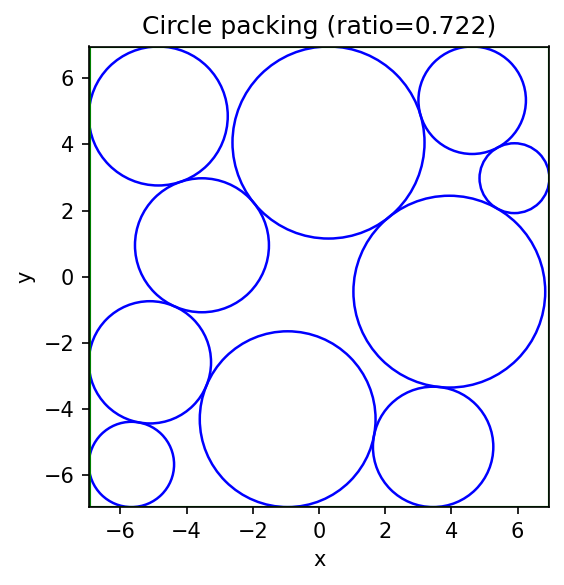Circle packing¶
The aim is to arrange \(n\) circles in \(\mathbb{R}^2\) with given radii \(r_i\) for \(i=1,\ldots,n\), so that they do not overlap and are contained in the smallest possible square [Spe13]. The optimization problem can be formulated as
\[\begin{split}\begin{align}
\text{minimize} & \displaystyle \max_{i=1,\ldots,n}\bigl(\lVert c_i\rVert_\infty + r_i\bigr)\\
\text{subject to} & \, \lVert c_i - c_j\rVert_2 \ge r_i + r_j,\qquad 1 \le i < j \le n,
\end{align}\end{split}\]
where the variables are the centers of the circles \(c\_i \in \mathbb{R}^2\), \(i=1,\ldots,n\), and \(r_i\), \(i=1,\ldots,n\), are given data.
If \(\ell\) is the value of the objective function, the circles are contained in the square \([-\ell,\ell]\times[-\ell,\ell]\).
Model definition¶
In the following code, we solve the circle packing problem with CVXPY using DCCP.
[1]:
import cvxpy as cp
import matplotlib.pyplot as plt
import numpy as np
from dccp import is_dccp
rng = np.random.default_rng(1)
# number of circles
n = 10
# radii of circles
r = rng.uniform(1.0, 3.0, n)
# coordinates of circle centers
c = cp.Variable((n, 2))
# constraint eq.: (2)
constr = []
for i in range(n - 1):
for j in range(i + 1, n):
constr += [cp.norm(c[i, :] - c[j, :]) >= r[i] + r[j]]
# objective: minimize the maximum distance from the origin to the circle center + radius
prob = cp.Problem(cp.Minimize(cp.max(cp.max(cp.abs(c), axis=1) + r)), constr)
As we can see, the problem is not DCP compliant:¶
[2]:
print("The problem is DCP compliant:", prob.is_dcp())
The problem is DCP compliant: False
But we can solve it with DCCP!¶
[3]:
print("The problem is DCCP compliant:", is_dccp(prob))
result = prob.solve(method="dccp", solver="ECOS", max_iter=50, max_slack=1e-4, k_ccp=3)
assert prob.status == cp.OPTIMAL, "DCCP failed to find optimal solution"
assert result is not None, "DCCP failed to find a solution"
print("DCCP solver result:", result)
The problem is DCCP compliant: True
DCCP solver result: 6.957405524663564
Visual verification of the results¶
To verify the results we will plot each circle at its optimal position as found by the DCCP algorithm.
[4]:
from matplotlib.patches import Circle, Rectangle
# the original 'c' variable
circle_centers = prob.variables()[0]
max_expr = cp.max(cp.max(cp.abs(circle_centers), axis=1) + r)
assert max_expr.value is not None, (
"Optimization did not assign a value to the variable."
)
square_size = float(max_expr.value) * 2
pi = np.pi
ratio = pi * np.sum(np.square(r)) / (square_size**2)
# create plot to visualize the packing
fig, ax = plt.subplots(figsize=(4, 4))
ax.set_aspect("equal", adjustable="box")
fig.set_dpi(150)
# draw circles
for i in range(n):
x_val = circle_centers[i, 0].value
y_val = circle_centers[i, 1].value
if x_val is None or y_val is None:
msg = f"Circle center value not assigned for index {i}."
raise ValueError(msg)
circle = Circle(
(float(x_val), float(y_val)), # (x, y) center
r[i], # radius
fill=False, # outline only
ec="b",
lw=1.2, # edge color/width
)
ax.add_patch(circle)
# draw square border
border = Rectangle(
(-square_size / 2, -square_size / 2), # bottom-left
square_size,
square_size, # width, height
fill=False,
ec="g",
lw=1.5,
)
ax.add_patch(border)
# limits and cosmetics
ax.set_xlim(float(-square_size / 2), float(square_size / 2))
ax.set_ylim(float(-square_size / 2), float(square_size / 2))
ax.set_xlabel("x")
ax.set_ylabel("y")
ax.set_title(f"Circle packing (ratio={ratio:.3f})")
fig.tight_layout()
